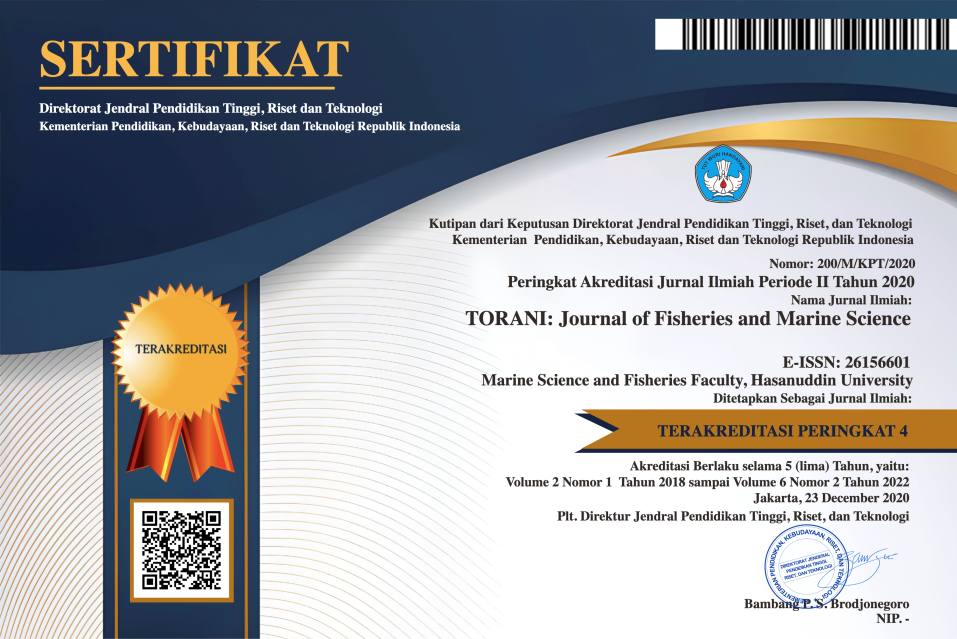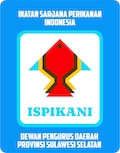Effect of Bacillus Sp. Bacteria on The Growth of Saline Tilapia (Oreochromis niloticus) in The Biofloc System
DOI:
https://doi.org/10.35911/torani.v5i2.20214Keywords:
Tilapia, protein retention, glycogen, bioflocAbstract
One alternative to increase production is to maximize the use of biofloc system cultivation technology. However, the problems in biofloc cultivation are; the difficulty of cultivators to replace or alternatively use commercial bacteria to increase production. One of the efforts made is the use of bacillus sp. The aim of the study was to determine the optimal concentration of bacillus sp that could increase the growth of saline tilapia. This study used a completely randomized design (CRD) with four treatments, each repeated three times, so that there were 12 units. This study tested the concentration of Bacillus sp. 0.0028 ml/L, 0.0030 ml/L, 0.0032 ml/L, and 0.0034 ml/L. The results showed that the highest protein retention was 9.91%, fat retention was 2.05% and the body glycogen content of saline tilapia was 0.68%. This shows that the administration of Bacillus sp. in saline tilapia culture media has a real effect.Downloads
References
Andhikawati, A., Handaka, A. A., & Dewanti, L. P. (2021). Penyuluhan budidaya ikan dalam ember (budikdamber) di desa Sukapura Kecamatan Dayeuhkolot Kabupaten Bandung. Farmers: Journal of Community Services, 2(1), 47-51.
Djauhari, R., Widanami, W., Sukenda, S., Suprayudi, M. A., & Junior, M. Z. (2020). Kinerja Pertumbuhan Dan Status Kesehatan Ikan Mas (Cyprinus Carpio) Yang Diberi Probiotik Bacillus Sp. Np5, Prebiotik Dari Ubi Jalar (Ipomoea Batatas L.) Dan Sinbiotik. Kinerja Pertumbuhan Dan Status Kesehatan Ikan Mas (Cyprinus Carpio) Yang Diberi Probiotik Bacillus Sp. Np5, Prebiotik Dari Ubi Jalar (Ipomoea Batatas L.) Dan Sinbiotik, 129-139.
Direktorat Jenderal Perikanan Budidaya.2020. Program Bioflok 2020 Mulai Dipanen, Untuk Ketahanan Pangan Dan Kesejahteraan Masyarakat.Diakses 20 Desember 2021. https://kkp.go.id/djpb/artikel/26923-program-bioflok-2020-mulai-dipanen-untuk-ketahanan-pangan-dan-kesejahteraan-masyarakat.
Effendie, M. I. (1997). Biologi perikanan. Yayasan Pustaka Nusatama. Yogyakarta, 163.
Faridah, F., Diana, S., & Yuniati, Y. (2019). Budidaya Ikan Lele Dengan Metode Bioflok Pada Peternak Ikan Lele Konvesional. Caradde: Jurnal Pengabdian Kepada Masyarakat, 1(2), 224-227.
Fenanza, (2021). Minapoli : Peran Kelompok Bakteri Bacillus Spp dalam Pengelolaan Lingkungan Tambak. Diakses 1 Juni 2022. https://www.minapoli.com/info/peran-kelompok-bakteri-bacillus-spp-dalam-pengelolaan-lingkungan-tambak.
Gaspersz, V. 1991. Metode Perancangan Percobaan. CV.Armico. Bandung.
Lestari, R. (2019). Pemberian Bakteri Heterotrof Terhadap Laju Pertumbuhan Dan Retensi Protein Pada Ikan Nila (Oreochromis Niloticus) Dengan Sistem Tanpa Ganti Air (Doctoral Dissertation, Universitas Sultan Ageng Tirtayasa).
Malik, D., Rahmawati, N. O., Puspitasari, O., Aprilensia, D., Annisa, P., & Yonarta, D. (2021). Penerapan Sistem Budikdamber pada Pakan Probiotik Dalam Memperkuat Ketahanan Pangan di Era Covid-19. In Seminar Nasional Lahan Suboptimal (Vol. 9, No. 2021, pp. 476-481).
Novia Suriani, N. S. (2018). Aplikasi Berbagai Probiotik Komersil Bacillus Spp. Terhadap Tingkat Kelangsungan Hidup Dan Performa Pertumbuhan Benih Ikan Bandeng (Chanos Chanos) (Doctoral Dissertation, Universitas Mataram).
Putra, A. N. (2015). Laju metabolisme pada ikan nila berdasarkan pengukuran tingkat konsumsi oksigen. Jurnal Perikanan dan kelautan, 5(1), 13-18.
Permana, D., Siahaan, R. G., Claudi, N., Silaban, L. A., Rosalinda, C., Purnama, S. M., ... & Fajri, M. N. (2021). Budidaya Ikan Gurame Sistem Bioflok. Media Sains Indonesia.
Pramono, T. B., Sukardi, P., & Soedibya, P. H. T. (2018). Produksi Budidaya Ikan Nila (Oreochromis Niloticus) Sistem Bioflok Dengan Sumber Karbohidrat Berbeda. Asian Journal of Innovation and Entrepreneurship, 3(02), 198-203.
Priyono, S. (2021). Tingkat Penerimaan Masyarakat Terhadap Penerapan Sistem Cbib (Cara Budidaya Ikan Yang Baik) Pada Budidaya Pembesaran Ikan Lele Kolam Terpal Di Kecamatan Slawi Dan Kecamatan Lebaksiu Kabupaten Tegal. Indonesian Journal Of Fisheries Community Empowerment, 1(2), 130-140.
Qiang J, Yang H, He J, Wang H, Zhu ZX, Xu P. 2014. Comparative study of the effects of two high carbohydrate diets on growth and hepatic carbohydrate metabolic enzyme responses in juvenile GIFT tilapia Oreochromis niloticus. Turkish Journal of Fisheries and Aquatic Sciences 14: 515−525.
Rusdani, M. M., Waspodo, S. A. S., & Abidin, Z. (2016). Pengaruh Pemberian Probiotik Bacillus Spp. Melalui Pakan Terhadap Kelangsungan Hidup Dan Laju Pertumbuhan Ikan Nila (Oreochromis Niloticus). Jurnal Biologi Tropis, 16(1).
Septiani, S. (2012). Formulasi sediaan masker gel antioksidan dari ekstrak etanol biji melinjo (Gnetun gnemon Linn.). Students e-Journal, 1(1), 39.
Setyastuti, T. A., Sukamto, D., & Asmarany, A. (2020). Kelimpahan Bakteri Heterotrof Pada Tambak Dengan Jenis Mangrove Yang Berbeda Di Pulokerto Pasuruan. Chanos Chanos, 18(1), 7-17.
Setiawati, J. E., Adiputra, Y. T., & Hudaidah, S. (2013). Pengaruh penambahan probiotik pada pakan dengan dosis berbeda terhadap pertumbuhan, kelulushidupan, efisiensi pakan dan retensi protein ikan patin (Pangasius hypophthalmus). E-Jurnal Rekayasa dan Teknologi Budidaya Perairan, 1(2), 151-162.
Takeuchi, T. 1988. Laboratory work chemical evaluation of dietary nutrients.p.179-233. In: Watanabe, T. (Ed). Fish nutrition and mariculture JICA.The general aquaculture course. Kanagawa international fisheries training centre. Japan International Cooperation Agency (JICA), Tokyo, 233 pp
Ulya, M. (2019). Pengaruh Pemberian Probiona Pada Pakan Terhadap Retensi Protein, Laju Pertumbuhan, Dan Kelangsungan Hidup Ikan Lele Dumbo (Clarias gariepinus) (Doctoral dissertation, University of Muhammadiyah Malang).
Ulkhaq, M F., Widanarni., Angela, ML. 2014. Aplikasi Probiotik Bacillus Untuk Pencegahan Infeksi Aeromonas Hydrophilla Pada Ikan Lele. Balai Penelitian dan Pengembangan Budidaya Air Tawar Sempur. Bogor
Watanabe, T. (1988). Fish nutrition and mariculture. Department of aquatic bioscience. Tokyo University of Fisheries. JICA.



















